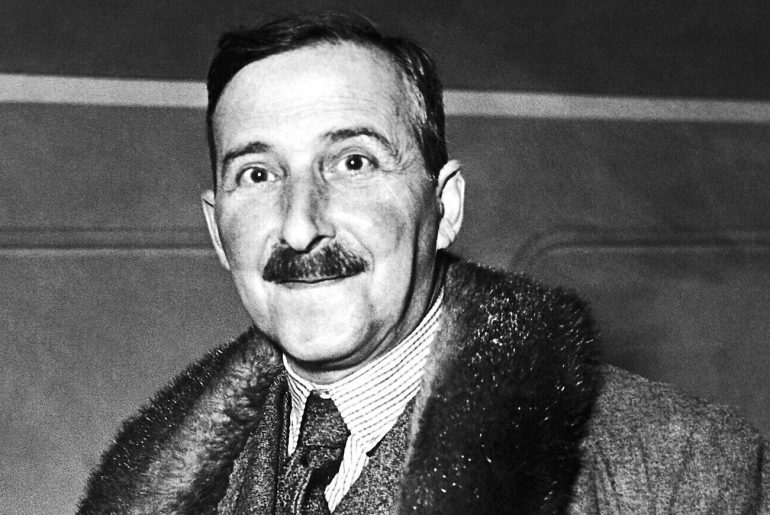After beginning in the tradition of Viennese modernism, the Austrian writer, storyteller, poet and essayist from the Jewish educated middle class created a psychologically differentiated work that identifies him as one of the last significant realists in German-language literature. Stefan Zweig became the most translated German author of his time. His wish was the creation of a humanistic basic understanding in Europe, which should reach through society to politics, in order to put an end to terror through the idea of nationalism…
Stefan Zweig was born on November 28, 1881 in Vienna, the son of the wealthy Jewish textile entrepreneur Moritz Zweig and his wife Ida Brettauer.
Here he grew up in the Jewish educated middle class, together with his brother Alfred. The Zweig family was not religious. He passed his Matura at the Wasagymnasium in Vienna. It was here that Zweig wrote his first poems. At that time he was influenced by writers such as Hugo von Hofmannstahl and Rainer Maria Rilke. In 1901, Stefan Zweig’s first volume of poetry was published, entitled “Silberne Saiten”. He also began translating works by French writers at this time. In 1904 he completed his doctorate in German and Romance Studies. By 1910 he was on numerous trips through Europe. The focus here was on the exchange with other writers and artists, with whom he mostly maintained friendships through intensive correspondence. By 1911, works such as “Tersites”, “The House by the Sea” or “Burning Secret” as well as his first biography “Émile Verhaeren” had been created.
With his writing First Experience. Four Stories from Children’s Land, Zweig approached an intuitive psychological style. At the beginning of the First World War, Stefan Zweig volunteered. Here he was employed in the war press headquarters until 1917. In order to demonstrate against the war in any form, he wrote the drama “Jeremias”, which premiered in Zurich in 1918. From 1918, Zweig also worked as a journalist and correspondent for the Swiss newspaper “Neue Freie Presse”. He also uses this medium to publish his non-party views. After the end of the war he settled in Salzburg. It was his idea to found an intellectually, holistically and humanistically motivated alliance in Europe. So he began, initially in numerous lectures and essays, to warn against radicalization through nationalism and to call for calm, diplomacy and patience.
In 1920, Zweig published the writings “Fear”, “Der Zwang” and from 1920 three essays on master builders of the world: “Three Masters”, 1925 “The Fight with the Demon” and 1928 “Three Poets of Your Life”. In 1926, Zweig celebrated great success on the stage with the adaptation of Ben Jonson’s “Volpone”. Just as successful was the publication of the book “Sternstunden der Menschen” in 1927. In 1928 he traveled to the Soviet Union, where his books were also published in Russian at the instigation of Maxim Gorki, with whom he corresponded. After the NSDAP took power in Germany, Stefan Zweig fled to London for fear of persecution. This is where the book “Impatience of the Heart” was written. From 1934 his work was no longer published in Germany and with the annexation of Austria to the Third Reich in 1938 production in his homeland also stopped. In 1935, Zweig wrote the libretto for the opera “The Silent Woman” for Richard Strauss.
In 1936 the NSDAP immediately banned the sale of all his works. His first marriage ended in divorce in 1938 and his second marriage in 1939 to Charlotte Altmann. In 1940 he received English citizenship from Great Britain. Nevertheless, he left Europe and traveled on to New York. In 1942 his chess novella and the monograph Brazil were published. After a short stay he visited Argentina and Paraguay. He then settled in Brazil. Here Stefan Zweig fell into deep sadness and depression.
Stefan Zweig committed suicide on February 22, 1942 in Petrópolis, near Rio de Janeiro. In 1944 his autobiography was published posthumously under the title “The World of Yesterday”.
Where is Stefan Zweig buried?
Petrópolis Municipal Cemetery, Petrópolis, State of Rio de Janeiro, Brazil
Is Stefan Zweig public domain?
The author died in 1942, so works by this author are also in the public domain in countries and areas where the copyright term is the author’s life plus 75 years or less.
Why is Stefan Zweig important?
Stefan Zweig; (28 November 1881 – 22 February 1942) was an Austrian novelist, playwright, journalist and biographer. At the height of his literary career, in the 1920s and 1930s, he was one of the most widely translated and most popular writers in the world.
Where did Stefan Zweig live?
Zweig was raised in Vienna. His first book, a volume of poetry, was published in 1901. He received a doctorate from the University of Vienna in 1904 and traveled widely in Europe before settling in Salzburg, Austria, in 1913.
How many books has Stefan Zweig written?
The Royal Game
1943
The World of Yesterday
1941
Letter from an Unknown Woman
1922
Beware of Pity
1939
Fear
1925
Amok
1922
What did Stefan Zweig write?
Stefan Zweig (1881–1942) was born to a prosperous Jewish family in Vienna, Austria. During World War I, he wrote the influential anti-war tragedy Jeremias. This 1917 work was an unsparing indictment of an insane war.





